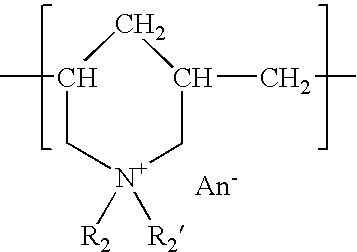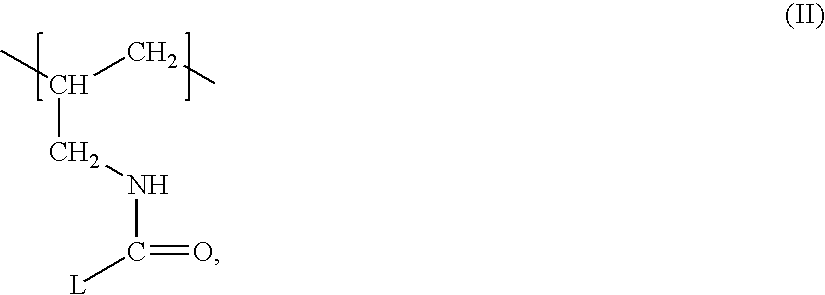LbL-coated medical device and method for making the same
a medical device and coating technology, applied in the field of lbl-coated medical devices and methods for making the same, can solve the problems of complex and time-consuming pretreatment of the substrate surface, difficult to be implemented in an automated production process, and low cost effectiveness of the technique, etc., and achieves low charge density and high hydrophilicity and lubricity.
- Summary
- Abstract
- Description
- Claims
- Application Information
AI Technical Summary
Benefits of technology
Problems solved by technology
Method used
Image
Examples
example 1
Measurements of CoF of Coated Contact Lenses
[0120] COF may be one of parameters that measure the easiness of the on-eye movement of a contact lens. High CoF may increase the likelihood of damaging mechanically the ocular epithelia. CoF of a contact lens can be measured by a sled-on-block type of friction tester as follow. Under a certain load (e.g., about 2.0 grams), a contact lens is slid back and forth, at a prescribed speed, against a biologically relevant substrate and both the normal force (N) and the tangential force (FT) are measured. The CoF of the contact lens is calculated based on the equation of μ=FT / N.
[0121] A preferred friction tester comprises: a stationary lens holder assembly, a biologically relevant substrate, a horizontally movable platform, and a plurality of force measuring means.
[0122] The stationary lens holder assembly preferably comprises an “A-shaped” holder bracket and a lens holder having a lens-supporting surface. The lens-supporting surface of the le...
example 2
Measurements of Contact Angles of Coated Contact Lenses
[0128] Average contact angles (Sessile Drop) of contact lenses are measured using a VCA 2500 XE contact angle measurement device from AST, Inc., located in Boston, Mass. This equipment is capable of measuring advancing or receding contact angles or sessile (static) contact angles. The measurements are preferably performed on fully hydrated materials.
[0129] The contact angle is a general measure of the surface hydrophilicity of a contact lens. In particular, a low contact angle corresponds to more hydrophilic surface. The averaged contact angle of a contact lens, which is made of lotrafilcon A and without any coating (LbL or plasma), is about 112 degree.
example 3
[0130] Polyacrylic acid (PAA) solution: A solution of polyacrylic acid having a molecular weight of about 90,000, from PolyScience, is prepared by dissolving a suitable amount of the material in water to form a 0.001M PAA solution. The PAA concentration is calculated based on the repeating unit in PAA. Once dissolved, the pH of the polyanionic PAA solution is adjusted by adding 1N hydrochloric acid until the pH is about 2.5.
[0131] Poly(allylamine hydrochloride) (PAH) solution: A solution of poly(allylamine hydrochloride) (PAH) having a molecular weight of about 70,000, from Aldrich, is prepared by dissolving a suitable amount of the material in water to form a 0.001M PAH solution. The concentration is calculated based on the molecular weight of repeating unit in PAH. Thereafter, the pH of the polycationic PAH solution is measured and recorded. The pH is around 4.5
[0132] Polyvinylpyrrolidone (PVP) solution: A solution of polyvinylpyrrolidone (PVP, from Aldrich) having a molecular w...
PUM
| Property | Measurement | Unit |
|---|---|---|
| molecular weights | aaaaa | aaaaa |
| mol % | aaaaa | aaaaa |
| mol % | aaaaa | aaaaa |
Abstract
Description
Claims
Application Information
 Login to View More
Login to View More - R&D
- Intellectual Property
- Life Sciences
- Materials
- Tech Scout
- Unparalleled Data Quality
- Higher Quality Content
- 60% Fewer Hallucinations
Browse by: Latest US Patents, China's latest patents, Technical Efficacy Thesaurus, Application Domain, Technology Topic, Popular Technical Reports.
© 2025 PatSnap. All rights reserved.Legal|Privacy policy|Modern Slavery Act Transparency Statement|Sitemap|About US| Contact US: help@patsnap.com



